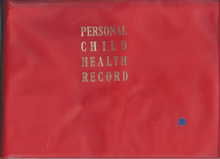Personal Child Health Record
A Personal Child Health Record or PCHR is a form of personal health record of the United Kingdom that records a child's growth, development, and use of health services.
Paper-based record

The paper based child health record as used by the UK National Health Service[1] is popularly known as the "Red Book." It is given to the parents on or just after the birth of their child, and is used by parents to record standard health details such as height and weight as well as developmental milestones such as first words and first time walking.[2] As the record has matured, additional information has been added in the form of inserts to aid parents with certain medical conditions, such as Down syndrome.[3] There are also sections that are typically completed by the child's GP or health visitor.
There are also additional updates from organisations such as the World Health Organization for growth chart updates [4][5]
The Scottish National Personal Child Health Record is available for download if you have a child born before January 2010.[6] The UK-WHO Growth Charts are also available for download.[7] EEPDwiki has links to more resources and examples of UK hand-held child health records.
A number of other countries have similar paper-based systems for sharing information between health professionals and parents.[8] The Japanese introduced a maternal and child paper record (Boshi techo) in 1947 with the aim of reducing perinatal mortality.[9] The current form of Mother Child Health Handbook (Boshi kenko techo) was introduced in 1966 and has been adapted for use in at least 20 countries worldwide.[10]
Electronic record
The online version has been developed by Sitekit www.eredbook.org.uk in partnership with NHS Digital the RCPCH, RCM, RCGP's, RCN and Harlow Printing – who print the current book.
An online version was earlier attempted by a Cambridge company called as redbabybook.com. The company is now defunct.
All the information is the same as in the print version, but the online version will do things such as prompting for scheduling appointments, checking test results online or providing links to NHS information. [11]
References
- "Your baby's health and development reviews". www.nhs.uk. 2017-12-21.
- Walton, Suzanne; Bedford, Helen; Dezateux, Carol; Millennium Cohort Study Child Health Group (2006). "Use of personal child health records in the UK: Findings from the millennium cohort study". BMJ. 332 (7536): 269–270. doi:10.1136/bmj.332.7536.269. PMC 1360395. PMID 16455721.
- "PCHR Insert for babies born with Down syndrome - Publications - DSMIG UK". dsmig.org.uk. Archived from the original on 2009-11-24. Retrieved 2009-11-04.
- "UK-WHO growth charts, 0-18 years". rcpch.ac.uk.
- UK adopts new growth charts based on breastfed babies
- "Health for all Children". healthforallchildren.co.uk.
- "UK-WHO growth charts, 0-18 years". rcpch.ac.uk.
- Hall, David M. B.; Hill, Peter; Elliman, David (1994). The Child Surveillance Handbook. ISBN 9781870905244.
- Takayanagi, K; Iwasaki, S; Yoshinaka, Y (Jan–Mar 1993). "The role of the Maternal and Child Health Handbook system in reducing perinatal mortality in Japan". Clinical Performance and Quality Health Care. 1 (1): 29–33. PMID 10135606.
- Nakamura, Yasuhide (July–August 2010). "Maternal and child health handbook in Japan" (PDF). JMAJ. 53 (4): 259–265. Retrieved 1 September 2012.
- eHealth Insider http://www.ehi.co.uk/news/ehi/8267/redbook-goes-digital